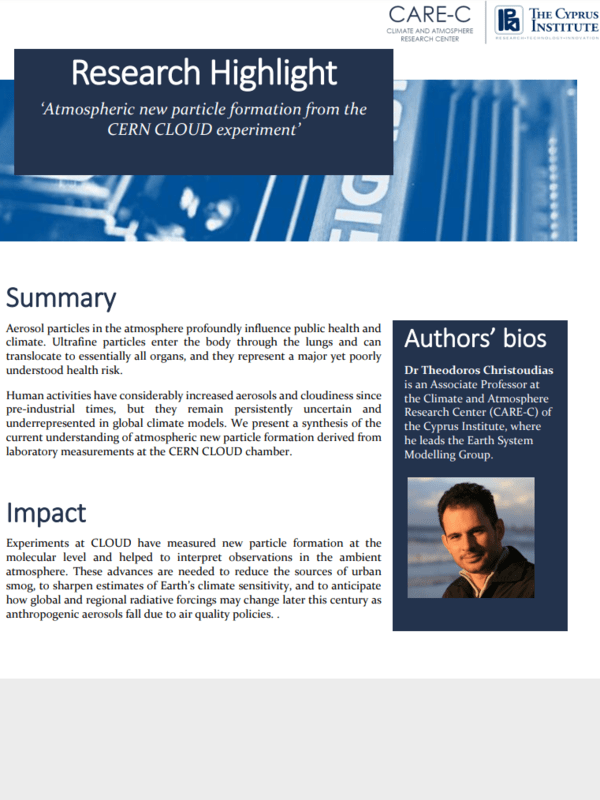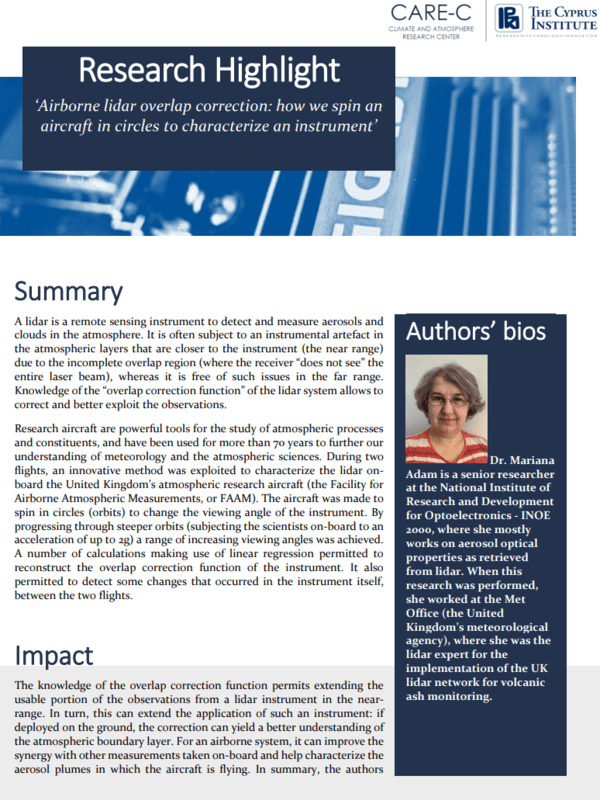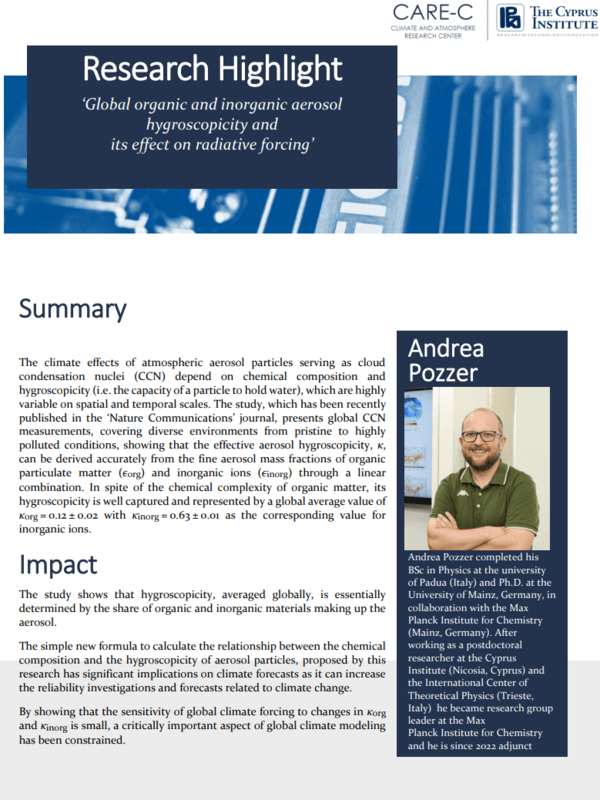Past Research Highlights

Atmospheric new particle formation from the CERN CLOUD experiment
Aerosol particles in the atmosphere profoundly influence public health and climate. Ultrafine particles enter the body through the lungs and can translocate to essentially all organs, and they represent a major yet poorly understood health risk.
Human activities have considerably increased aerosols and cloudiness since pre-industrial times, but they remain persistently uncertain and underrepresented in global climate models. We present a synthesis of the current understanding of atmospheric new particle formation derived from laboratory measurements at the CERN CLOUD chamber.

Airborne lidar overlap correction: how we spin an aircraft in circles to characterize an instrument
A lidar is a remote sensing instrument to detect and measure aerosols and clouds in the atmosphere. It is often subject to an instrumental artefact in the atmospheric layers that are closer to the instrument (the near range) due to the incomplete overlap region (where the receiver “does not see” the entire laser beam), whereas it is free of such issues in the far range. Knowledge of the “overlap correction function” of the lidar system allows to correct and better exploit the observations.
Research aircraft are powerful tools for the study of atmospheric processes and constituents, and have been used for more than 70 years to further our understanding of meteorology and the atmospheric sciences. During two flights, an innovative method was exploited to characterize the lidar on-board the United Kingdom’s atmospheric research aircraft (the Facility for Airborne Atmospheric Measurements, or FAAM). The aircraft was made to spin in circles (orbits) to change the viewing angle of the instrument. By progressing through steeper orbits (subjecting the scientists on-board to an acceleration of up to 2g) a range of increasing viewing angles was achieved. A number of calculations making use of linear regression permitted to reconstruct the overlap correction function of the instrument. It also permitted to detect some changes that occurred in the instrument itself, between the two flights.

Global organic and inorganic aerosol hygroscopicity and its effect on radiative forcing
The climate effects of atmospheric aerosol particles serving as cloud condensation nuclei (CCN) depend on chemical composition and hygroscopicity (i.e. the capacity of a particle to hold water), which are highly
variable on spatial and temporal scales. The study, which has been recently published in the ‘Nature Communications’ journal, presents global CCN measurements, covering diverse environments from pristine to highly polluted conditions, showing that the effective aerosol hygroscopicity, κ, can be derived accurately from the fine aerosol mass fractions of organic particulate matter (ϵorg) and inorganic ions (ϵinorg) through a linear combination. In spite of the chemical complexity of organic matter, its hygroscopicity is well captured and represented by a global average value of κorg = 0.12 ± 0.02 with κinorg = 0.63 ± 0.01 as the corresponding value for inorganic ions.

Improvement of atmospheric remote sensing measurement techniques
We introduce a new method for improving aerosol typing by lidar, through characterizing depolarization measurements using a reference system. Focusing on the Nicosia CIMEL CE376 lidar system and utilizing as reference the Polly XT in Limassol, our study retrospectively applies the approach to measurements obtained during the 2021 Cyprus Fall campaign. We focus here on how aerosol particles in the atmosphere affect the polarization of light, which allows to identify desert dust and other aerosols.
We emphasize the significance of precise lidar measurements in advancing our comprehension of atmospheric aerosols and their implications for climate and human health.

Health effects of carbonaceous PM2.5 compounds from residential fuel combustion and road transport in Europe
Exposure to fine particulate matter (PM2.5) is associated with an increased risk of morbidity and mortality. In Europe, residential fuel combustion and road transport emissions contribute significantly to PM2.5. Here, we study the contribution of the emissions from these sectors to long-term exposure and excess mortality in Europe. We quantified the impact of anthropogenic carbonaceous aerosols on excess mortality and performed a sensitivity analysis assuming that they are twice as toxic as inorganic particles. We find that total PM2.5 from residential combustion leads to 72,000 (95% confidence interval: 48,000–99,000) excess deaths per year, with about 40% attributed to carbonaceous aerosols. Similarly, road transport leads to about 35,000 (CI: 23,000–47,000) excess deaths per year, with 6,000 (CI: 4,000–9,000) due to carbonaceous particles. Assuming that carbonaceous aerosols are twice as toxic as other PM2.5 components, they contribute 80% and 37%, respectively, to residential fuel combustion and road transport-related deaths.

Field Evaluation of Low-cost Electrochemical Air Quality Gas Sensors at Extreme Temperature and Relative HumidityConditions
Modern electrochemical gas sensors hold great potential for improving practices in Air Quality (AQ) monitoring as their low cost, ease of operation and compact design can enable dense observational networks and mobile measurements.

Emerging extreme heat conditions as part of thenew climate normal
Based on an ensemble of global climate model simulations, we identify the absolute historical extremes expressed by several temperature indices. Considering projections under two future pathways (SSP1−2.6, SSP5−8.5), we investigate to what extent extreme heat conditions will become predominant during the rest of the century. The timing of a transition to prevailing hot weather extremes is critical for the development of mitigation and adaptation strategies; therefore, we also identify the projected first year
of such a transition, as well as the persistence in subsequent decades. Different aspects of heat extremes are investigated, including both maximum and minimum temperature.



